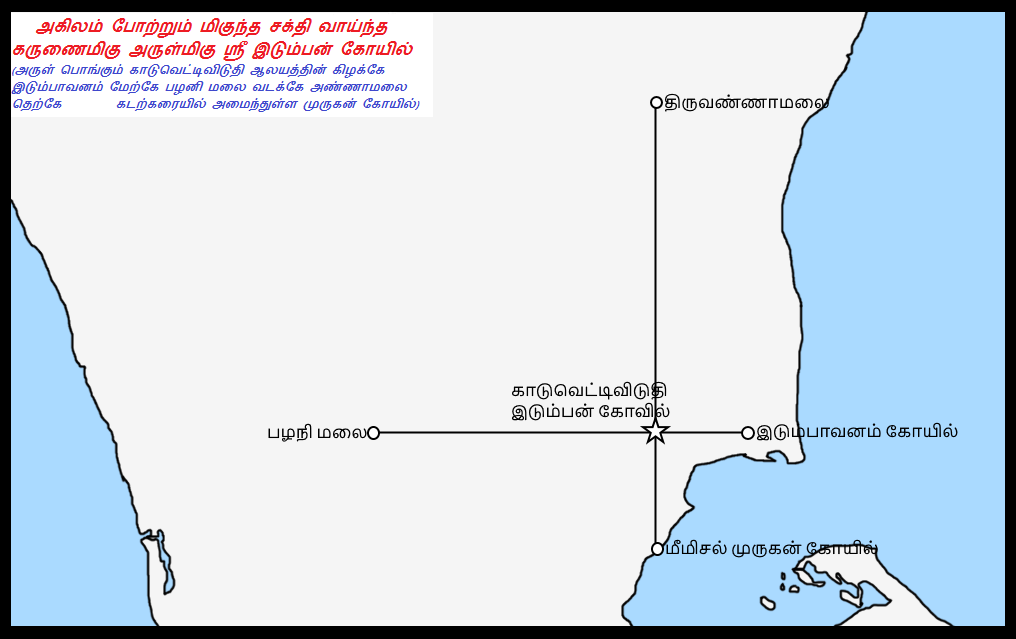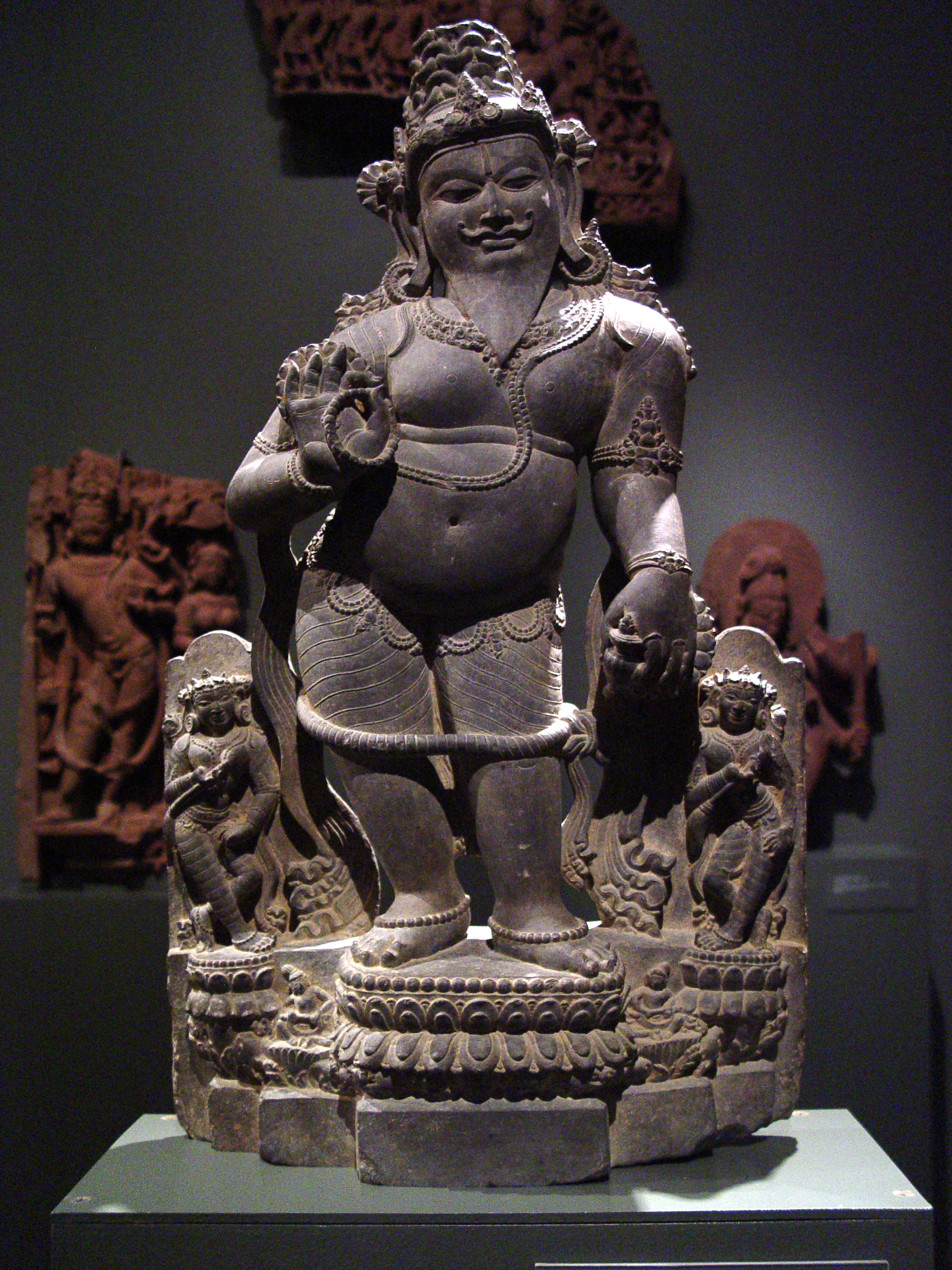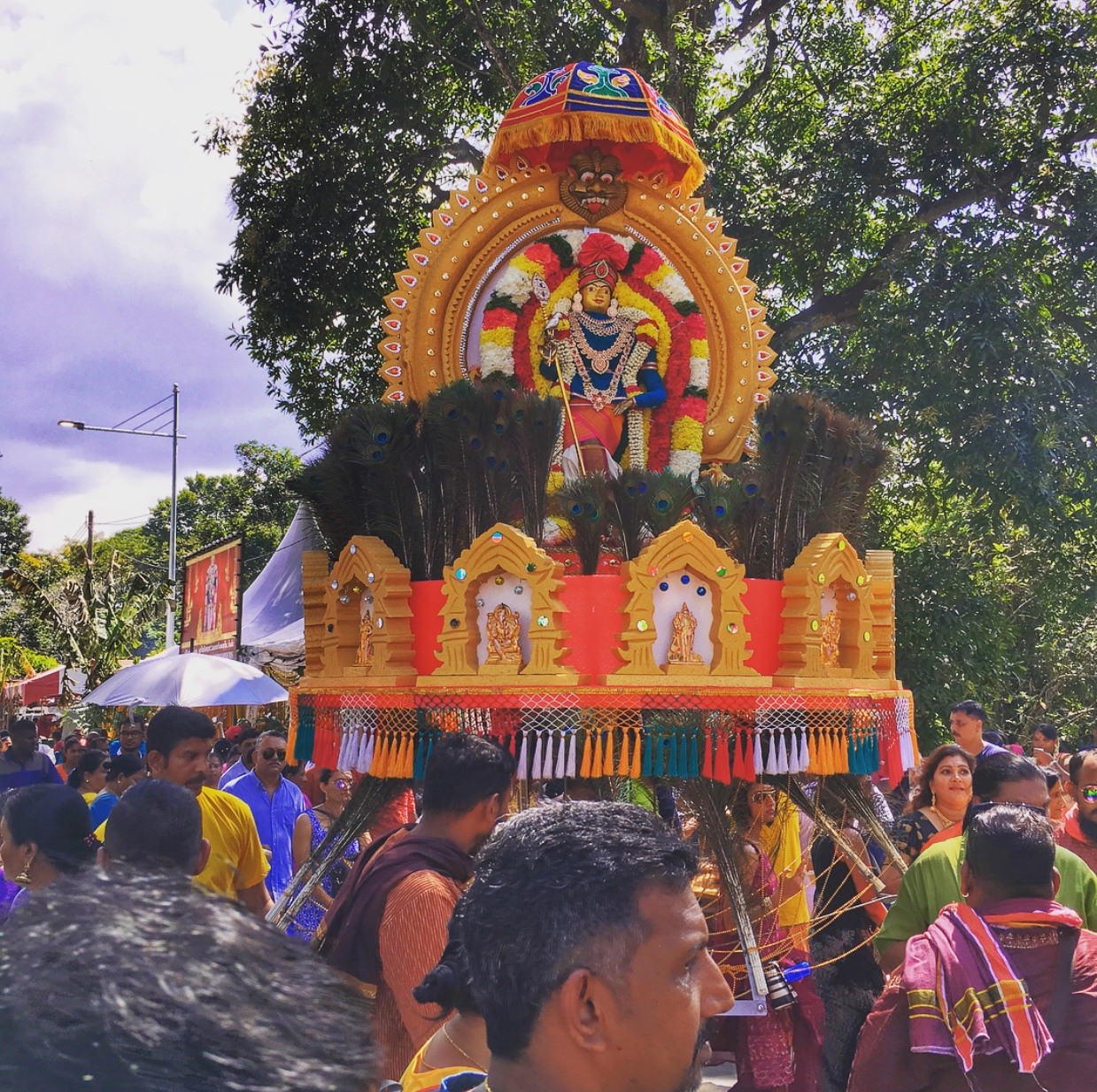|
Idumban Swami
Idumban is a great devotee of Lord Muruga and a great disciple of sage Agastya as well according to Tamil mythology. Idumban is also seen as one of the guardians of Muruga's temples in Tamil Nadu. During Thai Poosam celebrations in the Tamil month of Thai, Tamil people observe a ritual practice of Kavadi Aattam to obtain blessings from Muruga.In the ritual practice, before entering into the shrine, people used to worship Idumban. Mythology Sage Agastya wanted to take two hills - Sivagiri and Sakthigiri - to his abode in the South, and commissioned his disciple Idumban to carry them. Idumban bore the hills slung across his shoulders in the form of a 'kavadi' or a D-shaped object used to carry many items, one on either side. When he became fatigued by carrying the hills, he placed the 'kavadi' near Palani to take rest. Meanwhile, Muruga had been outwitted in a contest for going round the world. Ganesha Ganesha ( sa, गणेश, ), also known as Ganapati, Vinayaka, and ... [...More Info...] [...Related Items...] OR: [Wikipedia] [Google] [Baidu] |
Kartikeya
Kartikeya ( sa, कार्त्तिकेय, Kārttikeya), also known as Skanda, Subrahmanya, Shanmukha (), and Murugan ( ta, முருகன்), is the Hindu god of war. He is the son of Parvati and Shiva, the brother of Ganesha and a god whose legends have many versions in Hinduism. Kartikeya has been an important deity in the Indian subcontinent since ancient times, worshipped as Mahasena and Kumara in North India and is predominantly worshipped in the state of Tamil Nadu and other parts of South India, Sri Lanka, Singapore, and Malaysia as Murugan. Murugan is widely regarded as the "God of the Tamil people". It has been postulated that the Tamil deity of Murugan was syncretised with the Vedic deity of Subrahmanya following the Sangam era. Both Muruga and Subrahmanya refer to Kartikeya. The iconography of Kartikeya varies significantly; he is typically represented as an ever-youthful man, riding or near an Indian peafowl, called Paravani, bearing a vel and so ... [...More Info...] [...Related Items...] OR: [Wikipedia] [Google] [Baidu] |
Agastya
Agastya ( kn, ಅಗಸ್ತ್ಯ, ta, அகத்தியர், sa, अगस्त्य, te, అగస్త్యుడు, ml, അഗസ്ത്യൻ, hi, अगस्त्य) was a revered Indian sage of Hinduism. In the Indian tradition, he is a noted recluse and an influential scholar in diverse languages of the Indian subcontinent. He and his wife Lopamudra are the celebrated authors of hymns 1.165 to 1.191 in the Sanskrit text ''Rigveda'' and other Vedic literature. Agastya is considered to be the father of Siddha medicine. Agastya appears in numerous itihasas and Puranas including the major ''Ramayana'' and ''Mahabharata''. He is one of the seven most revered rishis (the Saptarishi) in the Vedic texts, and is revered as one of the Tamil Siddhar in the Shaivism tradition, who invented an early grammar of the Old Tamil language, Agattiyam, playing a pioneering role in the development of Tampraparniyan medicine and spirituality at Saiva centres in pro ... [...More Info...] [...Related Items...] OR: [Wikipedia] [Google] [Baidu] |
Tamil Culture
Tamil culture is the culture of the Tamil people. Tamil culture is rooted in the arts and ways of life of Tamils in India, Sri Lanka, Malaysia, Singapore, and across the globe. Tamil culture is expressed in language, literature, music, dance, theatre, folk arts, martial arts, painting, sculpture, architecture, sports, media, comedy, cuisine, costumes, celebrations, philosophy, religions, traditions, rituals, organizations, science, and technology. Language and literature Tamils have strong attachment to the Tamil language, which is often venerated in literature as "''Tamil̲an̲n̲ai''", "the Tamil mother". It has historically been, and to large extent still is, central to the Tamil identity. Like the other languages of South India, it is unrelated to the Indo-European languages of northern India. The Tamil language preserves many features of Proto-Dravidian, though modern-day spoken Tamil in Tamil Nadu freely uses loanwords from Sanskrit and English and vice versa. Also, ... [...More Info...] [...Related Items...] OR: [Wikipedia] [Google] [Baidu] |
Tamil Nadu
Tamil Nadu (; , TN) is a States and union territories of India, state in southern India. It is the List of states and union territories of India by area, tenth largest Indian state by area and the List of states and union territories of India by population, sixth largest by population. Its capital and largest city is Chennai. Tamil Nadu is the home of the Tamil people, whose Tamil language—one of the longest surviving Classical languages of India, classical languages in the world—is widely spoken in the state and serves as its official language. The state lies in the southernmost part of the Indian peninsula, and is bordered by the Indian union territory of Puducherry (union territory), Puducherry and the states of Kerala, Karnataka, and Andhra Pradesh, as well as an international maritime border with Sri Lanka. It is bounded by the Western Ghats in the west, the Eastern Ghats in the north, the Bay of Bengal in the east, the Gulf of Mannar and Palk Strait to the south-eas ... [...More Info...] [...Related Items...] OR: [Wikipedia] [Google] [Baidu] |
Thaipusam
Thaipusam or Thaipoosam (Tamil: தைப்பூசம், ''taippūcam'' ?), is a festival celebrated by the Hindu Tamil community on the full moon in the Tamil month of ''Thai'' (January/February), usually coinciding with Pushya star, known as Poosam in Tamil. The festival is also observed among Hindu Keralites and is vernacularly called Thaipooyam (Malayalam: തൈപ്പൂയം). It is mainly observed in countries where there is a significant presence of Tamil community such as India, Sri Lanka, Malaysia, Mauritius, as well as other places where ethnic Tamils reside as a part of the local Indian diaspora population such as Canada, Singapore, South Africa, the United States, Réunion, Indonesia, Thailand, Myanmar, Trinidad and Tobago, Guyana, Suriname, Jamaica and the other parts of the Caribbean. It is a national holiday in many countries such as Malaysia, Sri Lanka and Mauritius. In India its a state holiday in Tamil Nadu. In certain states of Malaysia and in the ... [...More Info...] [...Related Items...] OR: [Wikipedia] [Google] [Baidu] |
Kavadi Attam
Kavadi Aattam (Tamil: காவடி ஆட்டம், Malayalam: കാവടിയാട്ടം) ("Burden Dance") is a ceremonial sacrifice and offering practiced by devotees during the worship of Murugan,Kent, Alexandra. ''Divinity and Diversity: A Hindu Revitalization Movement in Malaysia''. University of Hawaii Press, 2005. () the Hindu god of war. It is a central part of the festival of Thaipusam and emphasizes debt bondage. The ''kavadi'' ("burden") itself is a physical burden, the bearing of which is used by the devotee to implore Murugan for assistance, usually on behalf of a loved one who is in need of healing, or as a means of balancing a spiritual debt.Hume, Lynne. ''Portals''. Devotees process and dance along a pilgrimage route while bearing these burdens. Legend The myth behind the practice of the ''kavadi aattam'' is steeped in Tamil mythology. At Mount Kailash, Shiva is said to have entrusted the sage Agastya with two hillocks, the Shivagiri hill, and the Sh ... [...More Info...] [...Related Items...] OR: [Wikipedia] [Google] [Baidu] |
Ganesha
Ganesha ( sa, गणेश, ), also known as Ganapati, Vinayaka, and Pillaiyar, is one of the best-known and most worshipped deities in the Hindu pantheon and is the Supreme God in Ganapatya sect. His image is found throughout India. Hindu denominations worship him regardless of affiliations. Devotion to Ganesha is widely diffused and extends to Jains and Buddhists and includes Nepal, Sri Lanka, Thailand, Indonesia (Java and Bali), Singapore, Malaysia, Philippines, and Bangladesh and in countries with large ethnic Indian populations including Fiji, Guyana, Mauritius, and Trinidad and Tobago. Although Ganesha has many attributes, he is readily identified by his elephant head. He is widely revered, more specifically, as the remover of obstacles and thought to bring good luck; the patron of arts and sciences; and the deva of intellect and wisdom. As the god of beginnings, he is honoured at the start of rites and ceremonies. Ganesha is also invoked as a patron of letters ... [...More Info...] [...Related Items...] OR: [Wikipedia] [Google] [Baidu] |
Palani Murugan Temple
Arulmigu Dhandayuthapani Swamy Temple is third of the Six Abodes of Murugan (Aarupadai veedugal). It is located in the city of Palani earlier it was known as ''Thiruaavinankudi(''as mentioned in the old Sangam literature Tirumurukāṟṟuppaṭai, Thirumurugatrupadai), Dindigul district, southeast of Coimbatore and northwest of Madurai in the foothills of the Palani Hills, Tamil Nadu, India. Palani temple is considered synonymous with ''Panchamritam'', a sweet mixture made of five ingredients. As per Hindu legendary beliefs, Sage Narada visited the celestial court of Shiva at Mount Kailash to present to him a fruit, the ''Jnana Palam, gnana-palam'' (literally, the fruit of knowledge). He decided to award it to whichever of his two sons who first encircle the world thrice. Accepting the challenge, Kartikeya, Murugan started his journey around the globe on his mount peacock. However, Ganesha, who surmised that the world was no more than his parents Shiva and Shakti combined, ci ... [...More Info...] [...Related Items...] OR: [Wikipedia] [Google] [Baidu] |
Idumban Temple
Idumban is a great devotee of Lord Muruga and a great disciple of sage Agastya as well according to Tamil mythology. Idumban is also seen as one of the guardians of Muruga's temples in Tamil Nadu. During Thai Poosam celebrations in the Tamil month of Thai, Tamil people observe a ritual practice of Kavadi Aattam to obtain blessings from Muruga.In the ritual practice, before entering into the shrine, people used to worship Idumban. Mythology Sage Agastya wanted to take two hills - Sivagiri and Sakthigiri - to his abode in the South, and commissioned his disciple Idumban to carry them. Idumban bore the hills slung across his shoulders in the form of a 'kavadi' or a D-shaped object used to carry many items, one on either side. When he became fatigued by carrying the hills, he placed the 'kavadi' near Palani to take rest. Meanwhile, Muruga had been outwitted in a contest for going round the world. Ganesha Ganesha ( sa, गणेश, ), also known as Ganapati, Vinayaka, and Pi ... [...More Info...] [...Related Items...] OR: [Wikipedia] [Google] [Baidu] |
Footnotes
A note is a string of text placed at the bottom of a page in a book or document or at the end of a chapter, volume, or the whole text. The note can provide an author's comments on the main text or citations of a reference work in support of the text. Footnotes are notes at the foot of the page while endnotes are collected under a separate heading at the end of a chapter, volume, or entire work. Unlike footnotes, endnotes have the advantage of not affecting the layout of the main text, but may cause inconvenience to readers who have to move back and forth between the main text and the endnotes. In some editions of the Bible, notes are placed in a narrow column in the middle of each page between two columns of biblical text. Numbering and symbols In English, a footnote or endnote is normally flagged by a superscripted number immediately following that portion of the text the note references, each such footnote being numbered sequentially. Occasionally, a number between brack ... [...More Info...] [...Related Items...] OR: [Wikipedia] [Google] [Baidu] |
Kaumaram
__NOTOC__ Murugan is a Hindu denomination that primarily venerates the Hindu deity of war, ''Kumaran'', also known as Murugan (in South India), ''Kandan'', or ''Kadamban'', or '' Kartikeya, aarumugan,'' . Most devotees of Kumaran also revere members of his family: Parvati, Shiva, and Ganesha, as well his consorts, Devasena and Sundaravalli, the daughters of Vishnu in Tamil tradition. The important theological texts relating to Kumara are a part of the Shaiva agama canon. This sub-tradition is found among the Tamils, Kannadigas, and the Vedda, in South India, Sri Lanka, and among the Tamil diaspora worldwide. The love story of Kumara/Murugan and his wife Valli, a girl from a local tribe, is popular in Tamil Nadu, where Kumara acquired the status of a national god. See also * Arunagirinathar * Deivayanai * Idumban * Mayura (mythology) * Six Abodes of Murugan * Vel Vel ( ta, வேல், lit=Vēl) is a divine javelin or spear associated with Murugan, the Hindu god of war. ... [...More Info...] [...Related Items...] OR: [Wikipedia] [Google] [Baidu] |






